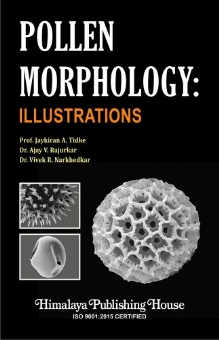Pollen Morphology Illustrations
no information available
The book entitled 'Pollen Morphology: Illustrations' is a focused approach in the Palynology dealing in particular with the Angiosperms Pollen Morphology. Pollen, a male gametophyte, has unique palynotaxonomical characters that distinguished its biological significance from other bio-entities. The book introduces a reader to the basics and significance of pollen morphology studies. The book contains a review of the various techniques for pollen preparations and the development of pollen morphological studies. Pollen preparation and other optimized techniques presented in the book can be successfully applied to many taxon of the angiosperms for morphological studies. The book consists of scanning electron micrographs of more than 150 species grouped as per the plant family. The SEM pictorial presentation is followed by the Palynotaxonomical characterization is a handy tool for the ease of understanding. The compiled pollen identification key is quick access to the species-specific pollen morphological characters. Contents - I. Introduction II. Historical Perspectives III. Pollen Preparation Techniques IV. Illustrations 1. Ranunculaceae 2. Annonaceae 3. Papaveraceae 4. Brassicaceae 5. Cleomaceae 6. Capparidaceae 7. Malvaceae 8. Tiliaceae 9. Elaeocarpaceae 10. Zygophyllaceae 11. Balsaminaceae 12. Rutaceae 13. Simaroubaceae 14. Meliaceae 15. Celastraceae 16. Rhamnaceae 17. Anacardiaceae 18. Moringaceae 19. Papilionaceae 20. Caesalpiniaceae 21. Mimosaceae 22. Crassulaceae 23. Combretaceae 24. Myrtaceae 25. Lecythidaceae 26. Lythraceae 27. Turneraceae 28. Caricaceae 29. Cucurbitaceae 30. Cactaceae 31. Rubiaceae 32. Asteraceae 33. Sapotaceae 34. Apocynaceae 35. Asclepiadaceae 36. Gentianaceae 37. Boraginaceae 38. Convolvulaceae 39. Solanaceae 40. Scrophulariaceae 41. Bignoniaceae 42. Pedaliaceae 43. Martyniaceae 44. Acanthaceae 45. Thunbergiaceae 46. Verbenaceae 47. Lamiaceae 48. Nyctaginaceae 49. Amaranthaceae 50. Polygonaceae 51. Euphorbiaceae 52. Amaryllidaceae 53. Alliaceae 54. Agevaceae 55. Dioscoreaceae 56. Liliaceae 57. Commelinaceae 58. Poaceae V. Pollen Identification Key VI. References ... Read more Read less











